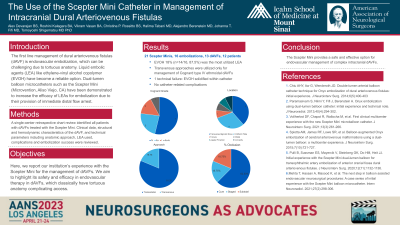The Use of the Scepter Mini Catheter in Management of Intracranial Dural Arteriovenous Fistulas
Friday, April 21, 2023


Alex Devarajan (he/him/his)
Medical Student
Icahn School of Medicine at Mount Sinai
New York, New York, United States
ePoster Presenter(s)
Introduction: Dural arteriovenous fistulas (dAVF) are abnormal fistulous connections between arteries supplying the dura mater and draining dural venous sinuses or cortical veins without an intervening capillary network. The first line management of dAVFs is endovascular embolization, which can be technically challenging due to the associated complex pathologic angioarchitecture. Liquid embolic agents (LEA) like ethylene-vinyl alcohol copolymer (EVOH) have become a reliable option for endovascular therapy. Dual-lumen balloon microcatheters such as the Scepter Mini (Microvention, Aliso Viejo, CA) have been demonstrated to increase the efficacy of LEAs for embolization due to their provision of immediate distal flow arrest. Here, we report our institution’s experience with the Scepter Mini for the management of dAVFs.
Methods: A single-center retrospective chart review identified all patients with dAVFs treated with the Scepter Mini. Clinical data, structural and hemodynamic characteristics of the dAVF, and technical parameters including anatomic approach, LEA used, complications and embolization success were reviewed.
Results: 21 Scepter Mini catheters were used in 16 embolizations of 13 dAVFs in 12 patients. The dAVFs were most commonly located in the transverse-sigmoid sinus (n=5/13, 38.46%), followed by the cribriform plate (n=4/13, 30.77%), and were most commonly Cognard type IV (n=7/13, 53.85%). EVOH 18% (n=14/16, 87.5%) was the most utilized LEA. Transarterial approaches were utilized in 13/16 embolizations, while transvenous approaches were utilized for management of Cognard type IV ethmoidal dAVFs (3/16, 18.75%). Technical failure occurred in 1/21 Scepter Minis when the LEA, EVOH 34%, solidified prior to injection requiring catheter replacement. Angiographic cure was demonstrated in 10/16 (62.5%) embolizations, with 3 patients scheduled for further staged embolization. No catheter-related complications were observed and non-catheter related complications were seen in 1/16 embolizations.
Conclusion : The Scepter Mini provides a safe and effective option for endovascular management of complex intracranial dAVFs.
Methods: A single-center retrospective chart review identified all patients with dAVFs treated with the Scepter Mini. Clinical data, structural and hemodynamic characteristics of the dAVF, and technical parameters including anatomic approach, LEA used, complications and embolization success were reviewed.
Results: 21 Scepter Mini catheters were used in 16 embolizations of 13 dAVFs in 12 patients. The dAVFs were most commonly located in the transverse-sigmoid sinus (n=5/13, 38.46%), followed by the cribriform plate (n=4/13, 30.77%), and were most commonly Cognard type IV (n=7/13, 53.85%). EVOH 18% (n=14/16, 87.5%) was the most utilized LEA. Transarterial approaches were utilized in 13/16 embolizations, while transvenous approaches were utilized for management of Cognard type IV ethmoidal dAVFs (3/16, 18.75%). Technical failure occurred in 1/21 Scepter Minis when the LEA, EVOH 34%, solidified prior to injection requiring catheter replacement. Angiographic cure was demonstrated in 10/16 (62.5%) embolizations, with 3 patients scheduled for further staged embolization. No catheter-related complications were observed and non-catheter related complications were seen in 1/16 embolizations.
Conclusion : The Scepter Mini provides a safe and effective option for endovascular management of complex intracranial dAVFs.
